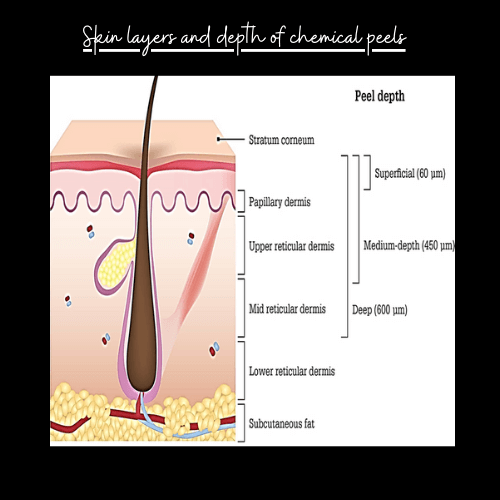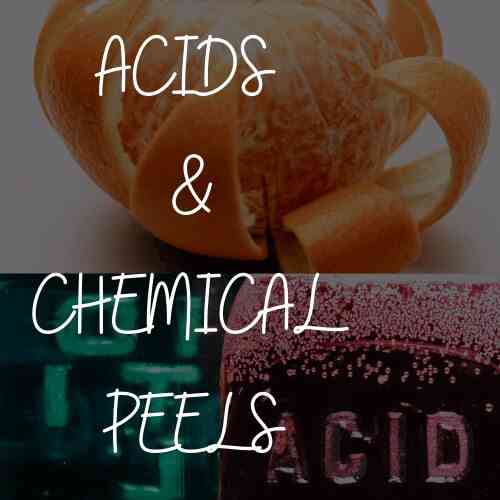(All references supporting the acid series are available at this LINK)
Introduction
I am starting a new series on exfoliating acids, which I will admit, is a topic that’s been written to death by researchers, beauty influencers, product manufacturers and so on. I can literally hear you ask,” why I another blog?”
Well, when I set out to answer this question, I couldn’t find a suitable answer:
“Based on my skin type, what are the exfoliating acids that I should be using and what are the side-effects?”
My skin’s characteristics are: Indian, wheatish/dark complexion, tan like there is no tomorrow, have hyper-pigmentation, scar easily, which does not easily fade and I’m not 25.
I decided to do the next best thing, read and research everything I could on this top and summarise everything I know in a series of blogs…
Before we dive in, a few definitions, as there is no reason to use “acids” with such artistic licence.
Acids
Th textbook definition is: acids are (generally) sour, form Hydrogen bonds with water, have a pH <7 and turn litmus paper blue. For chemical peels (see below), the concept of pKa is important. pKa is the pH at which half the solution is in free acid form – a low pKa value indicates a greater availability of free acid and therefore, a stronger peel.
Which acids am I looking at?
The only acids I am concerned about are:
- Glycolic Acid
- Salicylic Acid
- Lactic Acid
- Mandelic Acid and
- Gluconolactone.
Of these, only the first three acids are of practical importance as these are the most prevalent in skincare products. I know this because I looked at the Ingredient labels of 74 best-selling products (cleansers, toners and face masks) on the Sephora USA website. Specifically, I looked for the number of iterations or frequency of each acid in the Ingredient labels.
My main findings are:

P.S. I’ve made the underlying data available at this LINK.
Like you, I am unsure why so many folks refer to these acids: Tartaric Acid, Citric Acid, Pyurvic Acid, Malic Acid, as they are present in so few products. I will write a separate blog on them but we can ignore them.
Acids that I am not looking at: Kojic Acid, Azelaic Acid and Ascorbic Acid
These are not proper hydroxy acids and I find it confusing to throw these in the mix.
After that extremely lengthy introduction…
What’s the relationship between chemical peels and these acids?
The acids listed above (Glycolic, Lactic and Salicylic and Mandelic) have been used since the 1970s / 1980s in chemical peels – that’s nearly half a century. Therefore, most of the side effects of using these acids are properly documented in chemical peel related research.
Furthermore, I could argue that if (e.g.) someone uses a 30% Glycolic Acid solution at home, about 4 times a week (or 91 times a year), then the impact on their skin is comparable to a 30% Glycolic chemical peel. If they are using (e.g.) a retinol on the other 3 days of the week, then this mimics a chemical peel procedure even more as the pre-treatment phase for chemical peels can involve using retinoids, hydroquinone, Kojic Acid, and Azelaic Acid.
Therefore, the side-effects of both are likely to be similar.
Also, there is behaviourial issue at stake: once the individual sees fantastic results, there is a tendency to overuse the product without considering the serious side-effects.
Chemical peels
A chemical peel is a mechanism by which deliberate and controlled injury is caused to the facial skin with the intent to force new components of skin regeneration that make skin look younger. An at-home chemical exfoliation is an example of a chemical peel.
Chemical peels focus on reversing (albeit temporarily) the signs of ageing such as fine lines, wrinkles, pigmentation and facilitating smoother skin..
Different peels (using a range of acid concoctions) to target different layers of the skin.

Source: Chemical Peels (A review of current practices)Types of peels
There are 3 types of peels as follows:

At home treatments most closely resemble superficial peels, which generally address very mild photo-aged skin and aim to improve skin tone, fade dark spots and so on. They are also used for acne

Relation between chemical peels and Fitzpatrick skin type IV, V and VI*
I would argue (having been to India and being Indian), that most Indians are either Fitzpatrick IV, V and VI. These are characterised by this (crude, offensive and quite inadequate) industry standard scale:

With ethnic skin the problem is the “unpredictable response of melanocytes to injury that can cause disfiguring post-inflammatory change.”
Therefore, Deep peels are not at all recommended for Fitzpatrick type IV, V and VI individuals. While Medium peels are OK, you should consult a really, really good dermatologist before you go down this route.
The side-effects of using these acids…
I found this fantastic paper written in 1989, “Alpha Hydroxy Acids for Skincare – Smooth Sailing or Rough Seas?” published in the US Food & Drug Administration’s consumer magazine that highlights (perfectly) the side-effects of using these acids.
At that time, the FDA had received hundreds of complaints of adverse reactions to AHAs and based on their past experience, they estimated that manufacturers received 50-100 complaints for every complaint the FDA received…or 10,000 industry-related complaints.
The FDA were also concerned that AHAs could penetrate the skin barrier and affect the skin in a manner similar to chemical peels. Sounds familiar?
The AHA side-effects identified by the FDA were:
- Severe redness (or severe erythema)
- Swelling
- Burning
- Bleeding
- Rash, skin discolouration and blistering.
The side-effects depend on:
- product’s pH
- How its being delivered?
- Concentration of the AHA
- Frequency of use
- Where on the skin the product is applied.
The FDA’s concerns were that AHA’s make individual’s skin more suspectible to UVR damage, causing skin cancer.
American manufacturer recommendations reflect these concerns:
- Final packaging must indicate increased sun sensitivity and directs users to wear sunscreen
- Products to have a pH of 3.5 or greater
- The AHA concentration in products should be less than 10%
That’s it for now. In my next blog I’ll briefly describe the chemical structure of these acids…
Sources and uses
